Uninterrupted Work
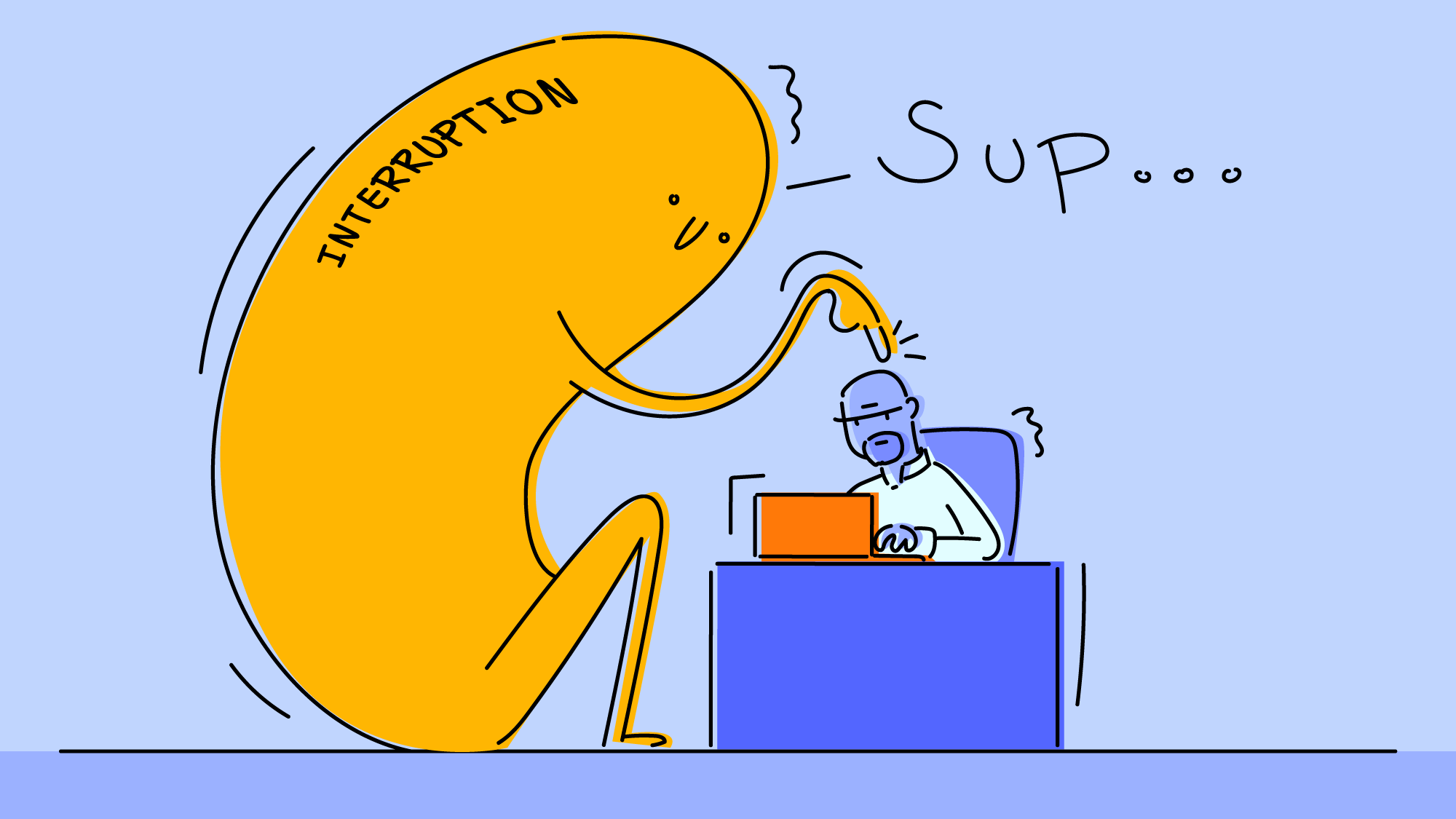
Neal Stephenson writes: "Four quiet hours is a resource that I can put to good use. Two slabs of time, each two hours long, might add up to the same four hours, but are not nearly as productive as an unbroken four."[1] In other words, interruptions are shockingly, seemingly-disproportionately bad for his novel-writing output.
Paul Graham expresses similar sentiments for coding: "A single meeting can blow a whole afternoon, by breaking it into two pieces each too small to do anything hard in."[2]
So did Samuel Taylor Coleridge, way back in 1797: he supposedly never finished his poem Kubla Khan because an unwanted intruder disrupted his flow of thought;[3] the intruder may have actually been himself, or his own thoughts, but that's another story.[4]
There's a couple of different models of why interruptions might be so costly, for any given activity:
- Non-linear returns to time spent on the activity
- High fixed startup costs for getting into the activity
Presumably one of these models is true for some activities and another for another, and in some cases both apply at once. But I’ve never seen them illustrated properly, so here they are.
Linear in output, no fixed startup cost
First, let’s consider an activity that doesn’t get harmed by interruption—stuffing envelopes might be an example here, if anyone still stuffs envelopes. Output is linear in the time spent doing it, and there is no cost to stopping and starting, so a five minute interruption costs you exactly five minutes of output and nothing more.
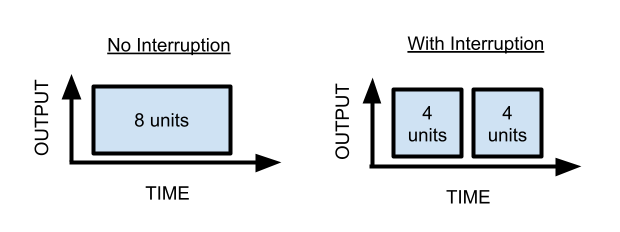
In this example: you produce 2 units of output per hour spent, regardless of how it’s broken up. A five minute interruption costs you five minutes. If you work another five minutes at the end, you get the same output you would have had anyway.
Non-linear in output, no fixed startup cost
Here’s the situation for a task which is non-linear in output. For this example, I’m going to say output is the square of continuous time spent, for ease of illustration, though for different tasks the output function will be different.
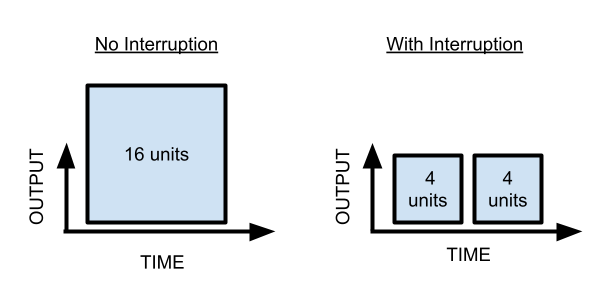
In this model, you can get 16 units of work done in 4 hours continuous hours, but a brief interruption in the middle leaves you with only 2^2 + 2^2 = 8 units of work, literally cutting your productivity in half.
By the way, in this model the timing of the interruption also matters:
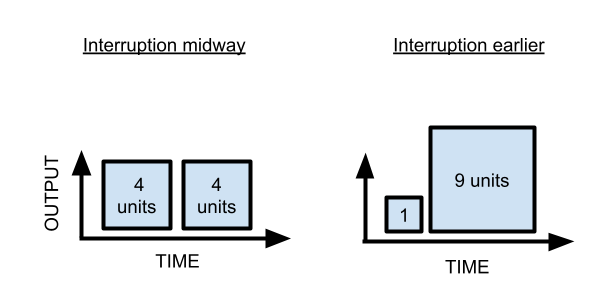
An interruption after one hour leaves you with 1^2 + 3^2 = 10 units of work, which is slightly better—it makes sense that, if we’re saying that productivity increases non-linearly with uninterrupted stretches of work, the more long stretches of uninterrupted work you manage, the better.
Linear output, fixed startup cost
A different model where interruptions are super costly is any situation where there’s a startup cost for getting into the task in the first place. For example, imagine a task where it takes you an hour to get started and then your output is linear, two units of output per hour.
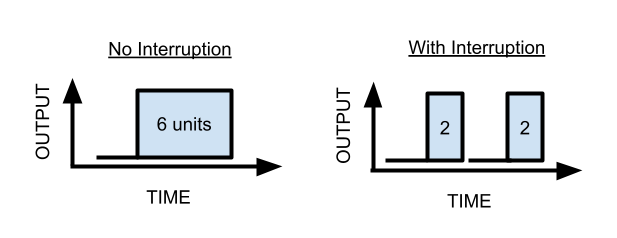
In this case, each interruption costs you two units of output (for the one hour of startup-time you now need to get back into things)—if you got interrupted once per hour, even very briefly, you would literally never get anything done.
Non-linear output, fixed startup cost
Finally, you might have both non-linear output and a startup cost after each interruption:
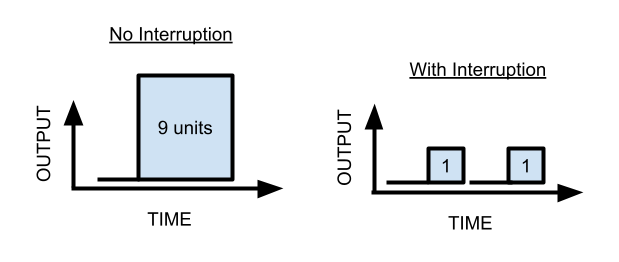
In this situation, the interruptions are even more expensive than before—each interruption causes you to re-pay the startup cost and cuts down the length of your available work-block, where the non-linear ouptut means that a shorter work block leads to much less output.
Tasks where your productivity decreases with time.
Just for completeness, it’s worth noting that there are tasks where you might actually expect a benefit from stopping and starting—for example, certain kinds of physical tasks and certain kinds of learning seem to benefit from “clumping”, with breaks in between.
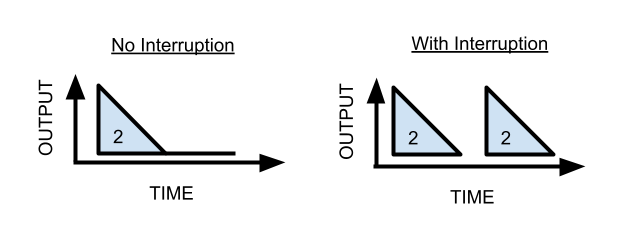
In this example, output degrades over the course of 2 hours, after which point flatlines at zero productivity—breaks actually make it possible to get more work done. (Yes breaks aren’t the same as interruptions, we know, just here as an illustration).
In conclusion
Given the strength of the “don’t interrupt me, it’ll ruin my work” meme, it’s kind of surprising that we don’t have better models of why different kinds of work require uninterruptedness.
What would really help, of course, is a model for figuring out which types of tasks are non-linear in output and which have high startup costs. If you're posessed of such a model please do add it in the comments.
With thanks to Jehan, Kaamya and Joseph
The full quote: "Writing novels is hard, and requires vast, unbroken slabs of time. Four quiet hours is a resource that I can put to good use. Two slabs of time, each two hours long, might add up to the same four hours, but are not nearly as productive as an unbroken four. If I know that I am going to be interrupted, I can’t concentrate, and if I suspect that I might be interrupted, I can’t do anything at all. Likewise, several consecutive days with four-hour time-slabs in them give me a stretch of time in which I can write a decent book chapter, but the same number of hours spread out across a few weeks, with interruptions in between them, are nearly useless. The productivity equation is a non-linear one, in other words." (Why I Am A Bad Correspondent) ↩︎
"When you're operating on the maker's schedule, meetings are a disaster. A single meeting can blow a whole afternoon, by breaking it into two pieces each too small to do anything hard in." (Maker’s Schedule) "The danger of a distraction depends not on how long it is, but on how much it scrambles your brain. A programmer can leave the office and go and get a sandwich without losing the code in his head. But the wrong kind of interruption can wipe your brain in 30 seconds." (Holding A Program In One’s Head) ↩︎
"The person from Porlock was an unwelcome visitor to Samuel Taylor Coleridge during his composition of the poem Kubla Khan in 1797. Coleridge claimed to have perceived the entire course of the poem in a dream (possibly an opium-induced haze), but was interrupted by this visitor from Porlock while in the process of writing it. Kubla Khan, only 54 lines long, was never completed. Thus "person from Porlock", "man from Porlock", or just "Porlock" are literary allusions to unwanted intruders who disrupt inspired creativity. " Wikipedia ↩︎
You might know the poem—it's the one that starts:
⠀
In Xanadu did Kubla Khan
A stately pleasure-dome decree:
Where Alph, the sacred river, ran
Through caverns measureless to man
⠀⠀⠀⠀⠀Down to a sunless sea.
⠀
I swear I had something interesting to say about this poem but before I could write it down I was interrupted by a damnable person from Porlock, and the thought was lost. ↩︎